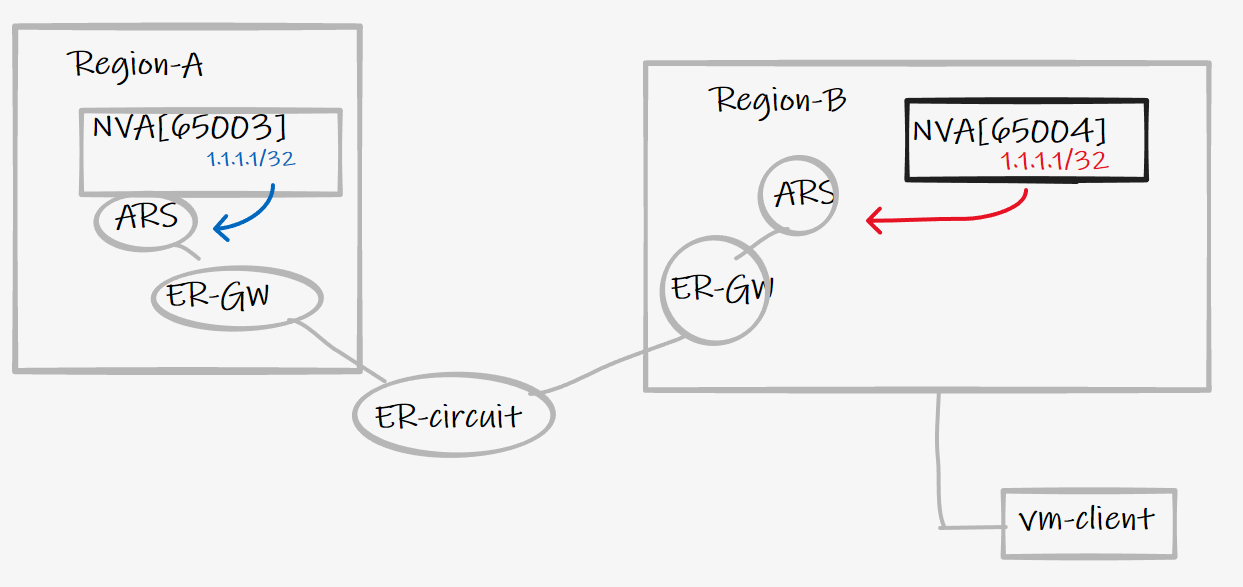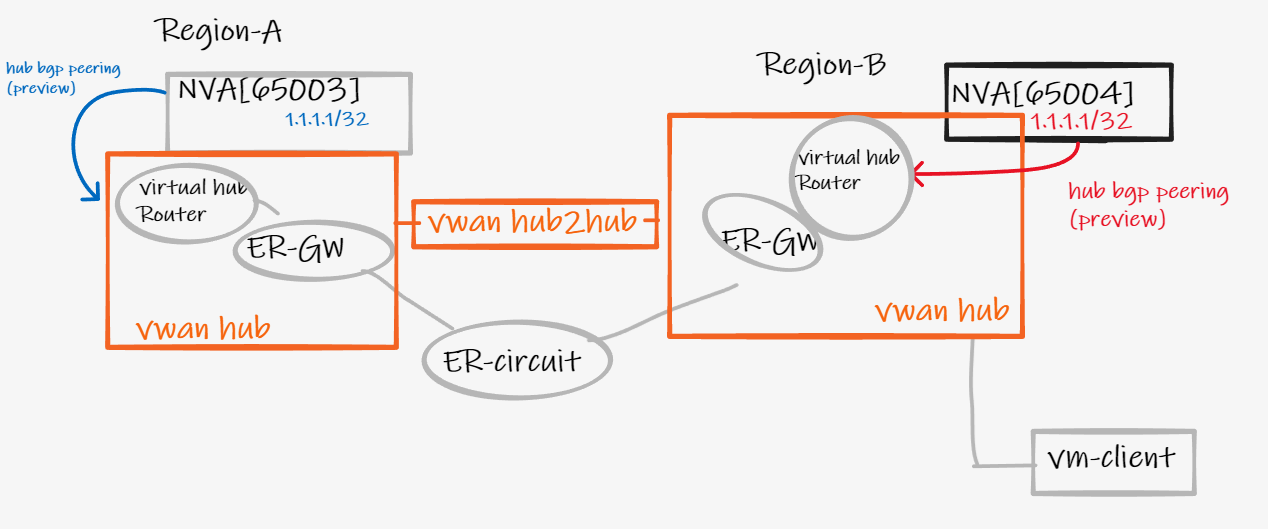The purpose of this article is to highlight differences in how the following features can be used in relation to Anycast designs, when working with inter-region (Azure-to-Azure) failure scenarios:
Both of these features are relatively new on the platform as of November 2021, and unlock the possibility for customers to inject (and receive) routes to/from the Azure SDN, via BGP.
💡 Note, this article is narrowly focused on Anycast loopback reachability between Azure regions (region to region), and not hybrid scenarios (onprem to Azure). The latter working with both products, detailed here and here.
NB. An Anycast loopback could equally be an SDWAN network advertised from the NVA. I.e. the same logic discussed herein applies to any prefix advertised by BGP from the NVA.
We need to pay attention to transit routing scenarios when working with Azure Route Server and branch-to-branch setting, don't assume too much transit routing via ExpressRoute MSEE.
- Region A NVA sends BGP loopback 1.1.1.1/32 to fabric via ARS or VWAN-BGP-Peering
- Region B NVA sends BGP loopback 1.1.1.1/32 to fabric via ARS or VWAN-BGP-Peering
- vm-client in region B accesses a service @1.1.1.1
- under normal conditions this is served from region-B
- what happens in failure scenarios?
- NVA[65004] advertises to ARS 1.1.1.1/32
- ARS injects this prefix in to VNet route table
- ARS also sends 1.1.1.1/32 to ER-circuit as branch-to-branch enabled on ARS
- vm-client accesses 1.1.1.1/32 with next-hop set as NVA[65004]
- NVA[65004] fails
- Local ARS stops injecting 1.1.1.1/32 in to local VNet
- does vm-client have a backup route to 1.1.1.1/32?
The answer is unfortunately, no. Logic is configured within ARS<>ERGW interaction to stop programming of remote routes with AS-PATH [12076 12076 {private as}] to prevent transit routing of onprem-to-onprem via ExpressRoute hairpin. Therefore the Anycast design does not function as required and despite the 1.1.1.1/32 route existing in Region A, there is no reachability from vm-client.
⚠️ Region A VNet routes are learnt by Region B via ExpressRoute MSEE Hairpin, but transit routes injected via region A ARS, are not programmed by ER-GW.
NB. This only happens if Branch-to-branch is enabled on the Azure Route Server in Region-B. This is somewhat of a moot point, as this is required to dynamically send the prefix to the other region via ER.
#showing output from hub-b
adam@Azure:~$ az network vnet-gateway list-learned-routes -n hub-ergw -g lab-ars-charley -o table | egrep "65002|65003|65520"
#interhub routes from VWAN
10.5.250.0/24 EBgp 172.16.178.4 12076-12076-65520-65520 32769 172.16.178.4
10.5.250.0/24 EBgp 172.16.178.5 12076-12076-65520-65520 32769 172.16.178.5
10.6.0.0/16 EBgp 172.16.178.4 12076-12076-65520-65520 32769 172.16.178.4
10.6.0.0/16 EBgp 172.16.178.5 12076-12076-65520-65520 32769 172.16.178.5
10.31.0.0/24 EBgp 172.16.178.4 12076-12076-65520-65520 32769 172.16.178.4
10.31.0.0/24 EBgp 172.16.178.5 12076-12076-65520-65520 32769 172.16.178.5
172.16.100.0/24 EBgp 172.16.178.4 12076-12076-65520-65520 32769 172.16.178.4
172.16.100.0/24 EBgp 172.16.178.5 12076-12076-65520-65520 32769 172.16.178.5
#routes from onprem
192.168.2.0/24 EBgp 172.16.178.4 12076-65000-65001-65001-65002 32769 172.16.178.4
192.168.2.0/24 EBgp 172.16.178.5 12076-65000-65001-65001-65002 32769 172.16.178.5
#routes from Hub-A
1.1.1.1/32 EBgp 172.16.178.4 12076-12076-65003 32769 172.16.178.4
1.1.1.1/32 EBgp 172.16.178.5 12076-12076-65003 32769 172.16.178.5
7.7.7.7/32 EBgp 172.16.178.4 12076-12076-65003 32769 172.16.178.4
7.7.7.7/32 EBgp 172.16.178.5 12076-12076-65003 32769 172.16.178.5
adam@Azure:~$ az network routeserver update --resource-group $rg --name $hubname-rs --allow-b2b-traffic true
"allowBranchToBranchTraffic": true,
adam@Azure:~$ az network vnet-gateway list-learned-routes -n hub-ergw -g lab-ars-charley -o table | egrep "65002|65003|65520"
192.168.2.0/24 EBgp 172.16.178.4 12076-65000-65001-65001-65002 32769 172.16.178.4
192.168.2.0/24 EBgp 172.16.178.5 12076-65000-65001-65001-65002 32769 172.16.178.5
192.168.2.0/24 IBgp 172.16.179.5 12076-65000-65001-65001-65002 32768 172.16.178.4
192.168.2.0/24 IBgp 172.16.179.4 12076-65000-65001-65001-65002 32768 172.16.178.4
tl;dr - same beahaviour if prefix originates from VWAN remote network injection, which includes default routes injected by Routing Intent for example i.e. Adding ARS + turning on B2B, to an existing VNet with ER-GW, will prevent it utilisation routes that are injected from remote VWAN Hubs. This can be an interesting design toggle/tool.
- NVA[65004] advertises to virtual hub router 1.1.1.1/32
- VWAN injects this prefix in to VNet route table
- VWAN also sends 1.1.1.1/32 to ER-circuit as branch-to-branch enabled on VWAN hub standard
- vm-client accesses 1.1.1.1/32 via VWAN Hub
- NVA[65004] fails
- Local VWAN hub stops injecting 1.1.1.1/32 in to local VNet
- does vm-client have a backup route to 1.1.1.1/32?
The answer is yes. The remote loopback in region A is learnt via the vwan hub2hub path. (NVA65003 > BGP peering > VWAN HUB A > H2H > VWAN HUB B). This transit via vwan hub2hub is allowed, and the Anycast address remains reachable, now served from Region-A.
Normal conditions, 9.9.9.9/32 served locally, note nexthop and as-path.
If NV65004 fails in region B, then recheck updated hub B route table, notice 9.9.9.9/32 is now served remotely via remote hub A.











